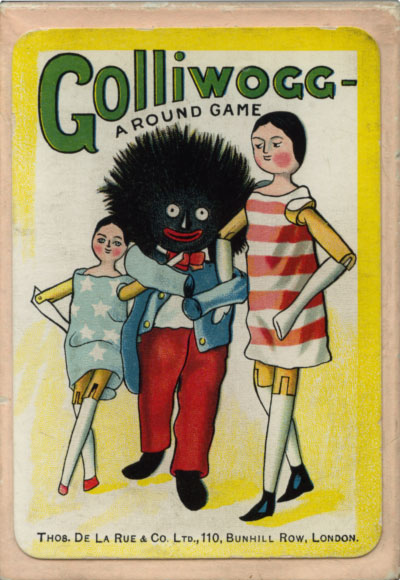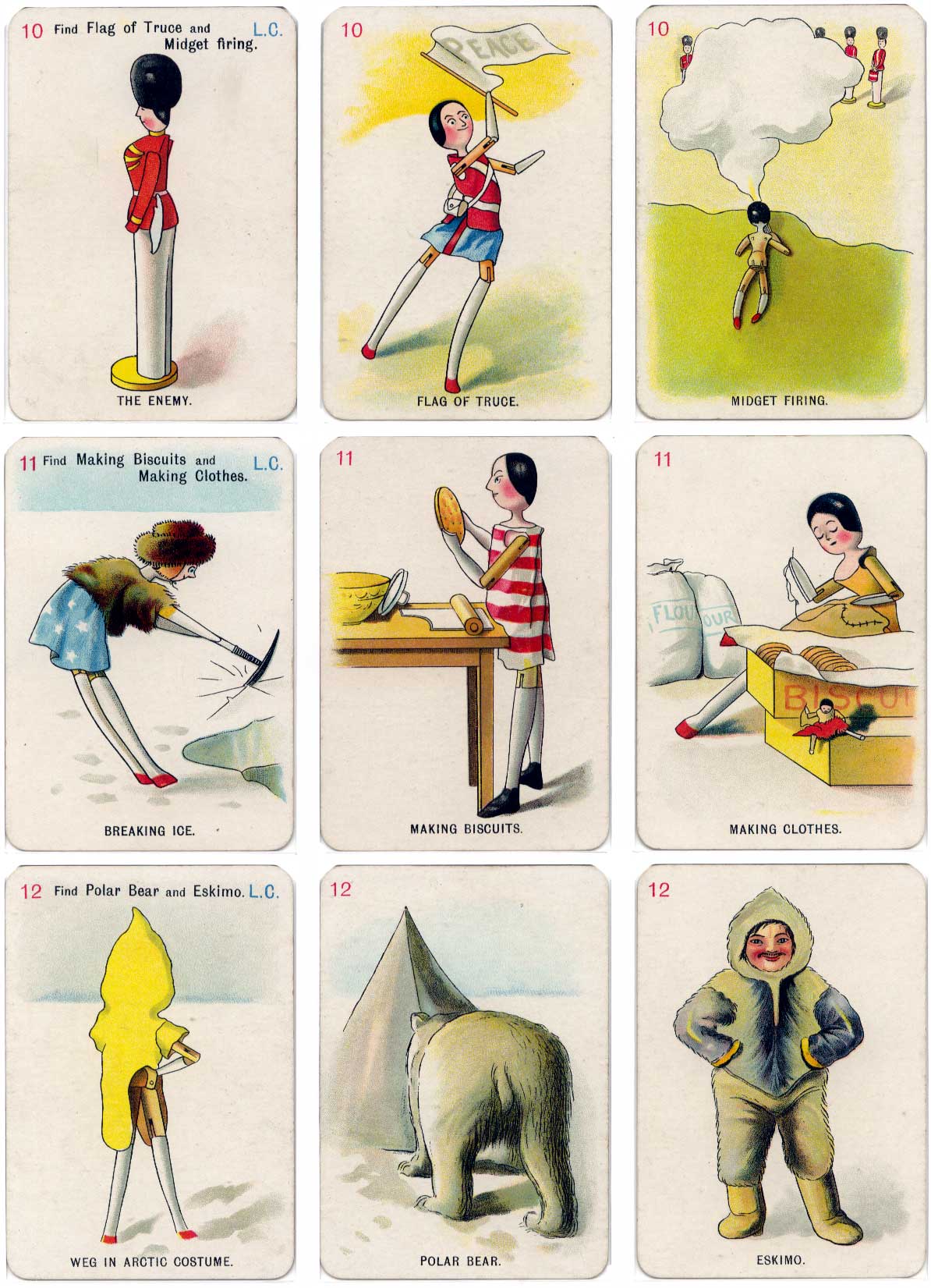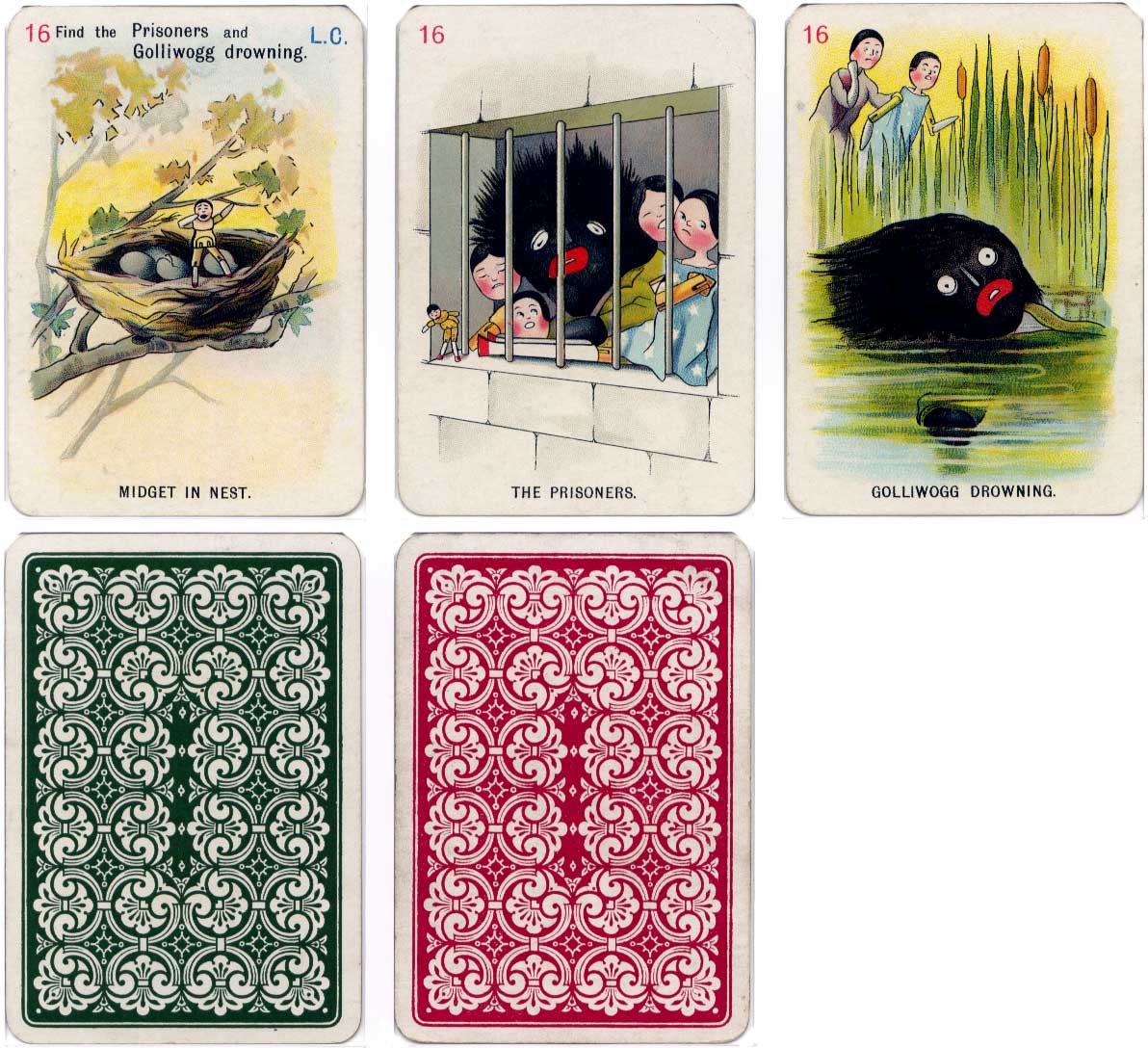Golliwogg, c.1902
The stories about the Golliwogg and the Dutch dolls were written by Bertha Upton (1849-1912) and illustrated by her daughter Florence Kate Upton (1873-1922)
The late Victorian stories about the Golliwogg and the Dutch Dolls (cheap German-made dolls known as Dutch dolls from a corruption of “Deutsch”) were written by Bertha Upton (1849-1912). Her daughter Florence Kate Upton (1873-1922) illustrated her mother’s books with the charming pictures which made them so popular. The books are highly collectable today, even though they have more recently been deemed offensive and inappropriate for children¹, and can fetch very high prices.
The same applies to the historical De la Rue card game which is based on the first seven Golliwogg books as shown on the rear of the box. This is a great aid to dating the card game because it confirms that it appeared before “The Golliwogg’s Circus” in 1903. The only other book that the Uptons published was called “The Vege-Men’s Revenge” published in 1897 but it never was as big a seller as the Golliwogg series.



Above: selection of cards from the “Golliwogg” card game illustrated by Florence Kate Upton (1873-1922) and published by Thos de la Rue & Co Ltd by arrangement with Messrs Longmans, Green & Co, c.1902. See an alternative box and back design►
¹ NOTE The black faced doll came out of the American tradition of black faced minstrels (which began around 1830) in which white men and a few black men wore intense black make up and sang songs in a fake Southern accent. When it came to the UK in the late 19th century it was very popular in the Music Halls and special Minstrel shows. The extremely popular children’s book “Little Black Sambo” was published in 1899 and was still on sale in the 1940s. Agatha Christie wrote “Ten Little Niggers” in 1939. Although the title was revised much later the stage adaptation was first performed in London entitled “Ten Little Niggers” later to become “Ten Little Indians” and finally “And then there were None”. In the 1927 film “The Jazz Singer”, the first talkie, Al Jolson appeared blacked up to sing some of the songs as he had been doing on the stage for years. Jolson himself, being a Jew, knew racial prejudice well and, ironically, campaigned against black prejudice. The Uptons who wrote the Golliwogg books had migrated to the USA and this may be the reason behind the stories where black faced dolls were commonplace. Many children had a golliwog doll but we know better now!

By Rex Pitts (1940-2021)
Member since January 30, 2009
Rex's main interest was in card games, because, he said, they were cheap and easy to get hold of in his early days of collecting. He is well known for his extensive knowledge of Pepys games and his book is on the bookshelves of many.
His other interest was non-standard playing cards. He also had collections of sheet music, music CDs, models of London buses, London Transport timetables and maps and other objects that intrigued him.
Rex had a chequered career at school. He was expelled twice, on one occasion for smoking! Despite this he trained as a radio engineer and worked for the BBC in the World Service.
Later he moved into sales and worked for a firm that made all kinds of packaging, a job he enjoyed until his retirement. He became an expert on boxes and would always investigate those that held his cards. He could always recognize a box made for Pepys, which were the same as those of Alf Cooke’s Universal Playing Card Company, who printed the card games. This interest changed into an ability to make and mend boxes, which he did with great dexterity. He loved this kind of handicraft work.
His dexterity of hand and eye soon led to his making card games of his own design. He spent hours and hours carefully cutting them out and colouring them by hand.
Related Articles

Scientific Whist
“Scientific Whist” : standard cards with instructions for play on the faces by Chas Goodall & Son, 1...

Agent Provocateur
Branded lingerie collection in a pack of pin-up playing cards.

Nimbus playing cards
Mike Steer’s weather-themed pack with suits in four colours and backs for cardistry.

Agatha Christie and Playing Cards revisited
Agatha Christie uses card-play as a primary focus of a story, and as a way of creating plots and mot...

The Decadent Deck
Studies in the eroticism of the female body by Inge Clayton.

Historic Shakespeare
“Historic Shakespeare” playing cards featuring Shakespearean characters by Chas Goodall & Son.

Copechat Paramount Sorting System
Preserving the past: a specimen deck showcasing edge-notched cards and their ingenious sorting syste...

Heartsette by Herbert Fitch & Co, 1893
A glimpse into a busy print and design office in late Victorian London.

Rap Rummy
Rap Rummy made by Parker Brothers in 1926, only 4 years after the discovery of King Tutankhamen’s to...

Batman® playing cards
Batman playing cards published by InterCol of London 1989.

Can You Believe Your Eyes?
“Can You Believe Your Eyes?” playing cards featuring visual illusions & other oddities.

Pastime Playing Cards for the Blind
The “Pastime” Playing Cards for the Blind manufactured by Goodall & Son Limd., c.1910.

The European Interchanges Quartets
A card game based around motorway intersections from European countries.

Songs with Flute accompaniment
Eighteenth century English engraved cards with music for voice and flute.

Love Tests
Vintage novelty “Love Test” cards of a slightly saucy nature but all in good fun!

Briefmarken-Quartett
Quartet game featuring postage stamps from the Zones of Occupation in post-WWII Germany.
Most Popular
Our top articles from the past 28 days










